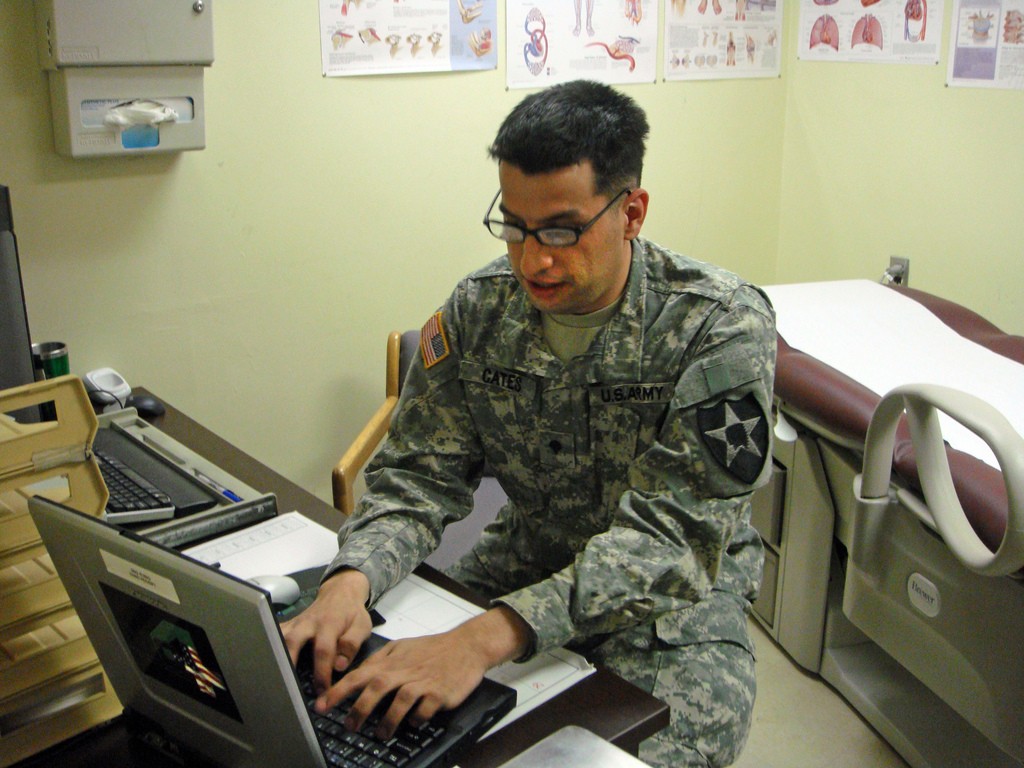Patients often have the luxury of urgent care facilities in the U.S. for after-hours care. There, practitioners on call typically treat ailments off the word of the patient, without visibility of the person's medical history or prior conditions.
The same occurs in battalion aid stations on U.S. posts for military personnel. The problem-the staff works with a fraction of the patient's medical picture and the treatments are rarely stored in digital format, leaving follow-on care providers with the same handicap.
This is not the case for the U.S. medical units in South Korea, where medical personnel are utilizing both the DoD's fixed facility electronic medical recording (EMR) system, AHLTA, and the battlefield system, <a href="http://www.mc4.army.mil" target="_blank">Medical Communications for Combat Casualty Care (MC4)</a>, to reap benefits on both sides of the data flow.
Capt. Christopher Mercer, physician assistant with the 1st Battalion, 15th Field Artillery Regiment at the Camp Hovey Combined Troop Aid Station (CTAS), South Korea, pulls weekend duty at an after-hours clinic at Camp Casey. Before he steps foot into the treatment room, he logs into AHLTA and reviews the patient's medical records that are often generated at lower levels of care using MC4.
"If a patient comes in suffering from sinusitis, I can see the person's allergies, the medications they're taking and the previous treatments for the same condition," Capt. Mercer said. "The ability to view medical records generated at the aid station in ALTHA saves valuable time when I need to make decisions about a patient's care. The accessibility to the information is easy and immediate."
In 2007, MC4 initially fielded systems to the 2nd Infantry Division to support the unit's medical exercises and to streamline their medical supply management efforts. System use and provider familiarity with the system blossomed, resulting in six battalion aid stations (BASs) installing MC4.
The medical information gap between BASs and the fixed facilities has since been bridged. Clinical staff amassed more than 10,000 patient encounters using MC4, with each record visible at various levels of care.
Implementation of the ruggedized hardware first took place at the Camp Casey CTAS by the 210th Fires Brigade under the direction of Maj. Cordes Pryor, a provider with the 210th Fires Brigade and commander of the Combined Troop Aid Station at Camp Casey. Without prior MC4 experience, she began using it with some hesitation, but soon realized the time savings it afforded her and her staff.
"MC4 is a tremendous improvement over paper records," Maj. Pryor said. "Before I see a patient, I bring up their medical record in AHLTA-T [on MC4] and scan the information entered by the medics. I see their current symptoms, as well as any previous treatments they received. Many of the Soldiers we see suffering from joint pain is the result of flat feet. I look over the notes to see if the patient has inserts, as well as if they are doing any weight training to strengthen the muscles. The electronic records save me a lot of time from flipping paper charts to find the information I need."
Maj. Pryor also covers shifts at the Camp Casey Family Health Clinic. She still reviews and documents patient notes digitally, but this time it is in the fixed facility EMR system-AHLTA. The benefit of having a compatible EMR system is the ability to view charts generated at the CTAS throughout the continuum of care.
"Patients arrive at the clinic requiring follow up care and tests ordered by their local provider," Maj. Pryor said. "Today, they do not have to carry around a paper version of their medical history and we do not have to request records from the aid stations. The EMRs streamline the medical process so that we are able to treat patients more efficiently, while having the complete medical history at our fingertips."
Treatment Expedited Through an Integrated EMR
Staff Sgt. Stephen Cunningham, the treatment noncommissioned officer in charge with the 1st Battalion, 15th Field Artillery Regiment at Camp Hovey, recalls one patient visiting the CTAS and urgent care clinic multiple times. Initially, the Soldier suffered from a dull ache in his abdomen that would not cease. Over time, the pain intensified and the Soldier became anemic. Different medications and a change in diet did not solve the problem.
Capt. Mercer compared notes and test results from the aid station and the urgent care clinic. He determined that the patient needed a referral to the 121st Hospital at Yongsan for an upper endoscopy and surgery.
"The Soldier was losing blood from an ulcer," Staff Sgt. Cunningham said. "If the condition continued to go untreated, the Soldier would have had serious health issues. Having access to the notes and test results in both MC4 and AHLTA prevented duplication of tests and procedures, leading to faster diagnosis and treatment for the patient."
Building upon a Soldier's medical history with the MC4 system also prepares the clinical staff to forecast future hurdles when they deploy to Iraq or Afghanistan. Staff Sgt. Cunningham reiterates this to the medics, often responsible for a patient's first digital medical record footprint.
"This is the same EMR system that I used when I deployed to Afghanistan in 2007," Staff Sgt. Cunningham said. "The use of MC4 in garrison provides the vital day-to-day training required to properly use the system in the deployed environment. I know that if my medics are required to deploy at moment's notice, they can step into any forward aid station and accurately capture a patient's medical information. This knowledge helps the medic, the Soldier and the unit."
For more information on the battlefield medical recording effort, visit <a href="http://www.mc4.army.mil" target="_blank">www.mc4.army.mil</a>.


Social Sharing